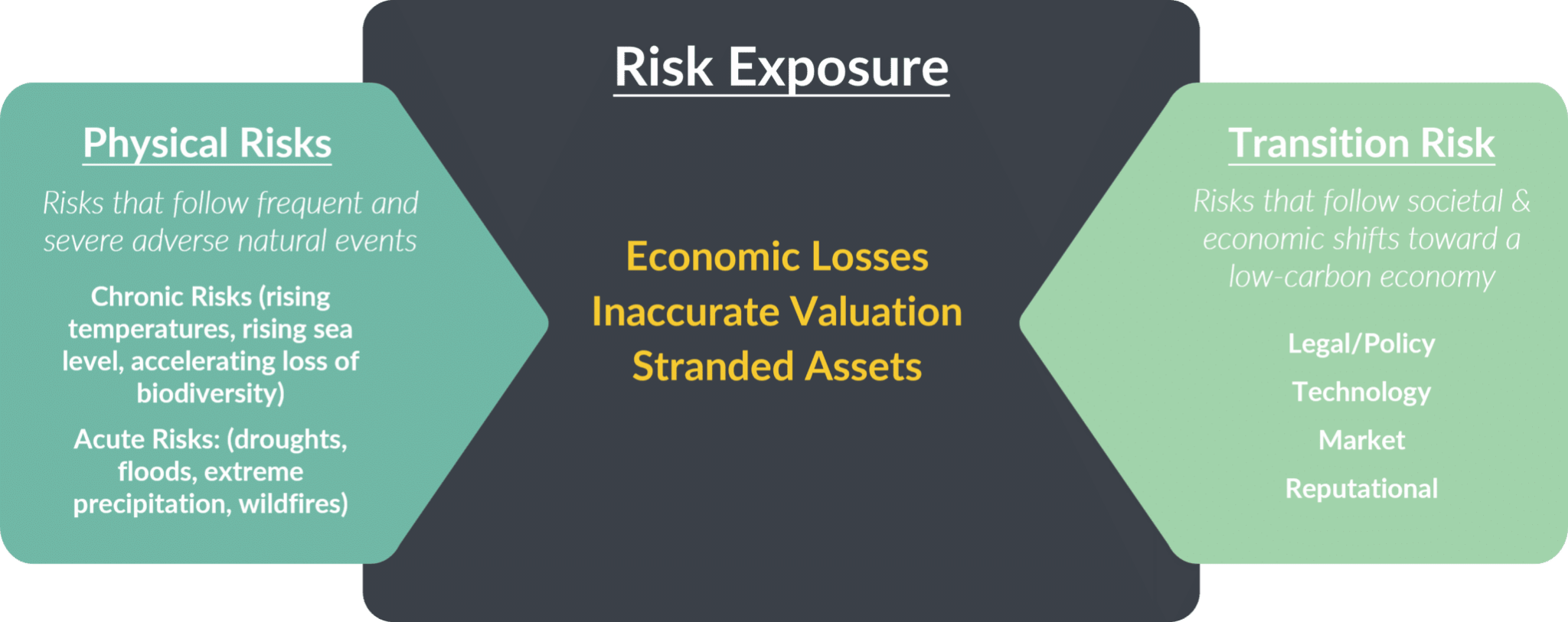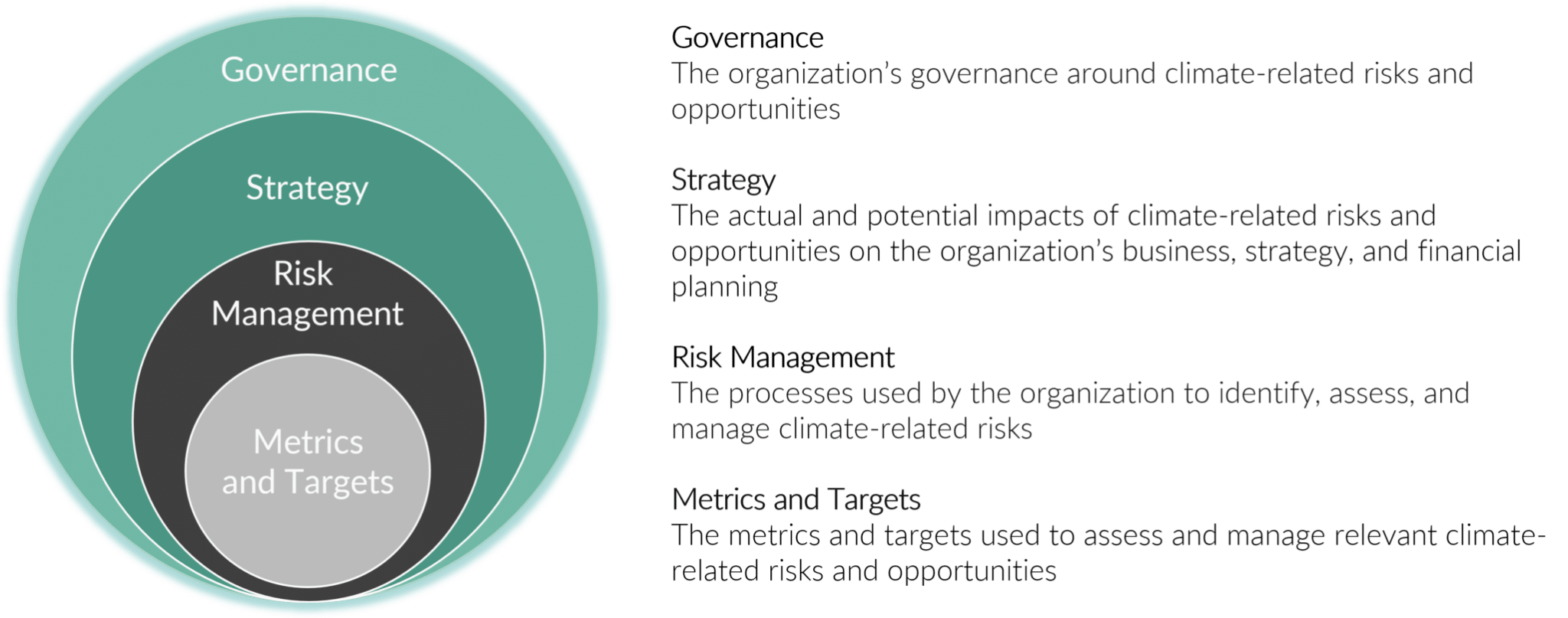Our industry is engaged in an important dialogue to improve sustainability through ESG transparency and industry collaboration. This article is a contribution to this larger conversation and does not necessarily reflect GRESB’s position.
Climate risks, such as floods, heat waves, droughts, and wildfires, pose a significant threat to the real estate industry. The direct and indirect financial impact of climate change is staggering. Climate-influenced weather events caused USD 165 billion of economic damage in the United States in 2022. This number is only expected to grow as floods, heat waves, droughts, and wildfires are two-to-four times more frequent since 1980.
Effective environment, social, and governance (ESG) program management and alignment to the Task Force on Climate-Related Financial Disclosures (TCFD) are key for identifying, assessing, and managing climate risks and opportunities.
What is climate risk?
Risks related to climate change are categorized into two types — transition climate-related risks and physical climate-related risks:
- Transition risks are the economic impacts that result from a shift to a lower-carbon economy and the resulting changes in regulatory standards and market trends. Examples include legal and policy, technology, market, and regulatory risks.
- Physical risks are the impacts of adverse weather events, including extreme weather events, sea level rise, and changing weather patterns. This type of risk also includes social issues that can arise from physical operational disruptions, such as commute and supply chain disruptions, declines in labor productivity, and brand reputation damage. The effects of physical climate-related risks can range from acute impacts to more chronic and gradual impacts.

Getting started with the TCFD
The good news is that every company has the opportunity to mitigate climate-related risk and to create value through effective management. Building owners, operators, and developers can look to the TCFD for streamlined guidance on addressing climate risk. The TCFD framework is designed to guide companies toward best practices in identifying, assessing, and managing climate-related risks and opportunities.

Prioritizing assets: Risk assessments using desktop tools
For physical risk, a unified risk assessment can address how much damage and business disruption an asset faces, as well as what it will cost. There are three parts to a unified risk assessment:
- Hazard scores answer “how likely is it that a location experiences high winds, flood water, fire, etc.?”
- Damage values and impact scores answer “what level of loss or disruption that should be expected at a location or for a portfolio?”
Together, this creates a unified risk assessment, which quantifies risk into a dollar value that companies can use for due diligence and prioritizing assets for risk mitigation measures. Desktop assessment tools provide functionality to conduct unified risk assessments at both the property and portfolio levels and align to the latest climate science. The TCFD framework recommends including a summary or a table of findings from a company’s risk assessment in public reporting.
Taking action: Onsite climate risk assessments
Once priority assets are identified from desktop assessments, companies can dig in deeper with a site-level assessment to uncover actionable mitigation plans at the asset level. The goal of a site-level climate resilience assessment is to anticipate and prepare the asset to respond to climate hazard events, limiting negative impact and business interruption that these events can cause and making assets more resilient.
These insights can be incorporated into asset level budget processes to plan for the resiliency of the property in the near, medium, and long term. For public reporting, the TCFD framework recommends including a description of the processes used to analyze identified risks and opportunities at the asset level.
Program management and the TCFD framework
The TCFD framework helps companies think about, prepare for, and manage climate risks. Alignment to TCFD’s four pillars of ESG management helps to manage risks, realize opportunities, and make progress toward the strategic goals of the organization. Once risks have been identified and analyzed, an external consultant can help to provide effective program management to ensure that findings are planned for and implemented accordingly. The four pillars are:
1. Governance: The company’s governance around climate-related risks and opportunities.
- What is the board’s oversight of climate-related risks and opportunities?
- What is the process and frequency of how the board and board committees are informed on climate-related issues?
- What is the organizational structure for managing climate-related issues and making decisions?
- How is management informed about issues and how do they monitor progress?
2. Strategy: The actual and potential impacts of climate-related risks and opportunities on the company’s business, strategy, and financial planning.
- What are the time horizons for near-, medium-, and long-term planning?
- Based on current risk assessments, what are the specific climate-related issues potentially arising in each time horizon (short, medium, and long term) that could have a material financial impact on the organization? What are the results from the unified risk assessment and what were the findings from the onsite climate resilience assessment?
- Utilize scenario analysis tools to understand the financial impact that the identified risks have on the organization’s portfolio over the short, medium, and long term.
- Utilize scenario analysis tools to understand the resilience of the organization’s strategy, taking into consideration different climate-related scenarios, including a 2°C or lower scenario.
3. Risk management: An organization’s approach to identifying, assessing, and mitigating risk.
- What is the company’s formal process for identifying, assessing, and managing risk and opportunity? Is there any documentation available if requested?
- How are climate-related risks integrated with the company’s overall risk management system?
4. Metrics and targets: An organization’s ESG-related goals and key performance indicators, as well as reporting on progress.
- What targets and metrics does the company have in place for guiding and monitoring progress?
- What are the company’s Scope 1, 2, and 3 greenhouse gas (GHG) emissions? How is the greenhouse gas inventory utilized to track and monitor progress toward targets?
Climate risk and opportunities with TCFD
Finally, in addition to identifying, assessing, and managing climate-related risks, the TCFD framework can help companies uncover opportunities that can drive innovation and value creation. Opportunities can be categorized into four categories: reducing costs, optimizing efficiencies, new products and services, and building new business models. Examples include:
- Resource efficiency provides direct cost savings and can also contribute to overall GHG emissions reductions.
- Energy sourcing to shift consumption toward renewable energy sources may potentially lead to energy cost savings.
- The development of new low-emission products and services can improve customer satisfaction, brand reputation, and competitive positioning.
- Stakeholder engagement and partnerships with governments, banks, and community groups can provide access to new markets.
- Resiliency is extremely important to companies with extensive supply chains and distribution networks and to companies that are heavily dependent on utility and infrastructure networks.
As companies dig into their climate risk journey, the TCFD website provides many free resources such as workshops in a box, example disclosures, and a knowledge hub. An external consultant can help you uncover actionable insights that can mitigate risks and also support reporting efforts such as TCFD. Your provider also should be able to give valuable recommendations for climate risk assessment software and finding a trusted resiliency vendor to support onsite technical resiliency assessments.
This article was written by Tavia Danch, Project Manager, ESG, at Stok.
References
Extreme weather, fueled by climate change, cost the U.S. $165 billion in 2022, NPR, Nathan Rott, January 10, 2023.